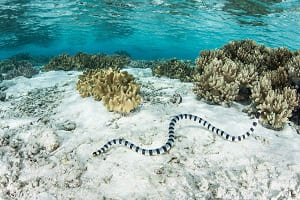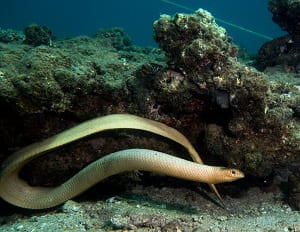Private Scuba › Best Scuba Destinations › Diving with Sea Snake
Best Place to Dive with Sea Snakes
Suppose you are not ophidiophobic and you want to scuba dive or snorkel with snakes. Where are you most likely to find sea snakes in the water?
This help guide lists seven of the best diving destinations around the world for divers and snorkelers to find marine snakes and sea kraits.
What are True Sea Snakes and Sea Kraits?
To begin with, ophidiophobia is a term used to describe someone with a persistent and overwhelming fear of snakes.
In fact, around one third (30%) of all adult human beings have a snake phobia.
We also accept that having a close encounter with a venomous marine reptile in water is not on every diver's wish list.
Nevertheless, this article caters for scuba divers and snorkelers who would welcome the underwater experience as one worth having.
The bottom line is this. There are several tragic reasons why the scuba diving death rate per year is higher than we want it to be. But, 'death from snake bite' is not the primary cause of these fatalities.
What is a True Sea Snake?
There are several key differences between true sea snakes and sea kraits. A true aquatic sea snake has developed an adaptation better suited to life as marine vertebrates, including:
- A flattish body with a short paddle-like tail (used for movement).
- An elongated lung that extends the entire length of its body.
- Small, juxtaposed scales that do not usually overlap (like paving stones).
- Valvular nostrils situated on top of the snout.
What is a Sea Krait?
Sea kraits (subfamily Laticaudinae) are semi aquatic, limbless reptiles that have closer relations with Asian cobras. They retain the wide ventral scales that are typical of their terrestrial cousins for crawling on dry land.
How Poisonous are Coral Reef Snakes?
One surprising fact is that many of the sea snake species contain more venom than the average land snake, and that includes cobras and rattlesnakes.
 Sea snake poison is 'highly' potent. But, most species have short hollow fangs and venom output is small.
Sea snake poison is 'highly' potent. But, most species have short hollow fangs and venom output is small.
Marine snakes are not aggressive by nature (unless they feel threatened and provoked).
So, human fatalities from snake bites are a rare occurrence (excluding careless fishermen).
7 Destinations to Swim with Water Snakes
The geographical distribution of aquatic sea snakes and sea kraits is large. However, you will not find any of these marine reptiles in the Atlantic Ocean, the Caribbean Sea, and areas with high salinity (e.g. the Red Sea, Egypt).
In essence, the best place for scuba divers to find sea snakes in the ocean is somewhat 'subjective'. Even so, the seven locations listed below should offer some useful facts and information.
Australia (The GBR)
Australia's Great Barrier Reef provides a habitat for a plethora of sea life plants and animals, including coral reef snakes. As a matter of fact, you can find up to fourteen (14) different snake species around the GBR, such as:
- Yellow-lipped sea kraits (Laticauda Colubrina).
- Olive sea snake (Aipysurus laevis), especially at the Lighthouse Bommie dive site on the Ribbon Reefs, north of Cairns.
Costa Rica (Central America)
Catching sightings of the yellow-bellied sea snake (Hydrophis platurus) is a common occurrence around the Pacific coast of Costa Rica.
The unique traits and characteristics of this pelagic snake species are remarkable. They have an elongated beak with a body that shows off a distinctive bicolour pattern.
Being an open-sea species means they use the prevailing ocean currents to move around. Like most reptiles, they are opportunistic feeders and catch their prey as the opportunity arises.
Pro Tip: Another section explains more about what sea snakes eat and why they can die of thirst if they don't get access to fresh water.
India (Andamans)
The sea snake genus Hydrophis contains more than sixty species which you can find in the Indian Ocean. Thus, it has a high diversity of water snakes and semi-aquatic kraits.
They inhabit many different types of coastal marine habitats (e.g. coral reef formations). But, they also thrive in estuaries, muddy ocean floors, rivers, and swamplands.
Note: Another section contains more information about the best dive spots around India, including the Maldives, the Andaman Islands, and Goa.
Indonesia (Gunung Api)
One of the most concentrated sea snake-rich destinations is the 'Volcano of the Sea Snakes'. This famous dive site is one hundred and twenty miles from any landmass in the Banda Sea.
 Of course, other great locations nearby include Bali dive sites, Komodo, and Lombok.
Of course, other great locations nearby include Bali dive sites, Komodo, and Lombok.
Even so, scuba diving at Gunung Api (aka Fire Mountain) is a populous area to find hundreds of the yellow-lipped sea krait.
The lava-encrusted shoreline swarms with different species of venomous sea snakes that seem to enjoy hunting in packs.
In fact, swimming together as a large group while they scavenge for food is one reason why they show very little fear towards scuba divers.
Pro Tip: The best months to dive at Gunung Api and Pulau Manoek for sea snakes are May to June (e.g. by joining one of the purpose-built diving liveaboards).
Taiwan (Green Island)
Despite being a small volcanic island, Green Island is Taiwan's seventh largest. You will find the diving area around thirty three (33) kilometres off the east coast in the Pacific Ocean.
The waters that surround Taiwan (formerly known as Formosa) provide an ideal habitat for several species of coral reef snakes, including:
- Amblyomma nitidum
- Black-banded sea krait
- Blue-lipped sea krait
- Emydocephalus ijimae
- Sinomicrurus sauteri
- Stokes's sea snake
- Yellow-lipped sea krait
Pro Tip: The Ijima's sea snake (also called the turtle headed sea snake) is quite small with a total length around eighty five (85) centimetres. It is highly venomous and the female usually gives birth to two young - in a normal litter.
Thailand
The list of amazing dive sites in Thailand is huge. In fact, there are so many that we made a separate section with detailed information and useful tips.
Nonetheless, if you want to swim around sea snakes you should definitely head out to some of the following areas:
Some of the species that are prevalent in Thai waters (e.g. the Andaman Sea) include the Annandale's sea snake, the Banded sea krait, and the Indian krait.
The Philippines
One of the top destinations in the world for scuba divers to find sea snakes has to be the islands that make up The Philippines.
The archipelago contains more than 7,100 islands and it covers almost 300,000 square kilometres. So, divers and snorkelers should head out to Apo Reef, Coron, Dauin, Malapascua, Palawan, and Puerto Galera.
In fact, Hunters Rock dive site at Apo Reef is an amazing location to see many different species of these limbless reptiles, especially the yellow-lipped sea krait (Laticauda colubrina).
Related Information and Help Guides
- Sea Snake Bite Symptoms and First Aid Treatment
- Best Destinations for Scuba Diving and Snorkeling
- What are Some Examples of Vertebrate Reptiles?
Note: The short video [2:49 seconds] contains some quick facts and answers about common venomous reptiles, sea kraits, and coral reef snakes.